Volume 1-8 (2009-16)
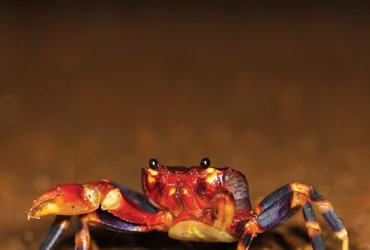 v7i1.154
v7i1.154ISSN: 1800-427X (print)
eISSN: 1800-427X (online)
DOI:10.47605/tapro.v7i1.154
Submitted date: 20 September 2014
Accepted date: 1 December 2014
Published date: 19 January 2015
Pp. 40–42.
On two rare cerambycid beetles (Coleoptera) from India
E. Vives & H. V. Ghate*
*Corresponding author. E-mail: hemantghate@gmail.com
Two unique cerambycid beetle species, which were collected from Kerala in 1997, were recently identified as Anoeme andrewesi Gahan, 1906 (Prioninae, Meroscelisini) and Zoodes maculatus (White, 1855), (Cerambycinae, Hesperophanini). Of the two species, Z. maculatus was previously only known from Sri Lanka; therefore, this is a new locality record and addition to the Indian faunal list of Cerambycidae. Types of both species are preserved in the Natural History Museum, London, UK (BMNH). Brief descriptions and color photographs of these two species are presented here. Both specimens were collected approximately 6 km North of Munnar, Kerala, India, on 14 April 1997, by a local collector. These are now preserved in E. Vives’s private collection, Barcelona, Spain.
Section Editor: Alain Drumont
eISSN: 1800-427X (online)
DOI:10.47605/tapro.v7i1.154
Submitted date: 20 September 2014
Accepted date: 1 December 2014
Published date: 19 January 2015
Pp. 40–42.
On two rare cerambycid beetles (Coleoptera) from India
E. Vives & H. V. Ghate*
*Corresponding author. E-mail: hemantghate@gmail.com
Two unique cerambycid beetle species, which were collected from Kerala in 1997, were recently identified as Anoeme andrewesi Gahan, 1906 (Prioninae, Meroscelisini) and Zoodes maculatus (White, 1855), (Cerambycinae, Hesperophanini). Of the two species, Z. maculatus was previously only known from Sri Lanka; therefore, this is a new locality record and addition to the Indian faunal list of Cerambycidae. Types of both species are preserved in the Natural History Museum, London, UK (BMNH). Brief descriptions and color photographs of these two species are presented here. Both specimens were collected approximately 6 km North of Munnar, Kerala, India, on 14 April 1997, by a local collector. These are now preserved in E. Vives’s private collection, Barcelona, Spain.
Section Editor: Alain Drumont
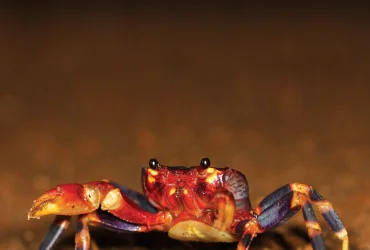 v7i1.153
v7i1.153ISSN: 1800-427X (print)
eISSN: 1800-427X (online)
DOI:10.47605/tapro.v7i1.153
Submitted date: 13 March 2014
Accepted date: 18 May 2014
Published date: 19 January 2015
Pp. 38–39.
Range extension of Perbrinckia scansor (Crustacea) in Sri Lanka
D.E. Gabadage, U.S.C. Udagedara & D.M.S.S. Karunarathna
*Corresponding author. E-mail: degabadage@gmail.com
Perbrinckia scansor (Ng, 1995) is the only known tree-climbing freshwater crab among the 52 freshwater crab species of Sri Lanka. According to published literature, this endemic species was recorded in eleven localities (elevation range 150–960m a.s.l) in the Kalu, Walawe and Gin River basins and assessed as “Least Concern”, but again this species was categorised as Endangered. This species is a habitat specialist with adults living in rainwater-filled phytotelms from about ground level up to 1 m above ground. We recorded the distribution of P. scansor from 47 localities through opportunistic observations within the period 2005–2010.
Section Editor: M.M. Bahir
eISSN: 1800-427X (online)
DOI:10.47605/tapro.v7i1.153
Submitted date: 13 March 2014
Accepted date: 18 May 2014
Published date: 19 January 2015
Pp. 38–39.
Range extension of Perbrinckia scansor (Crustacea) in Sri Lanka
D.E. Gabadage, U.S.C. Udagedara & D.M.S.S. Karunarathna
*Corresponding author. E-mail: degabadage@gmail.com
Perbrinckia scansor (Ng, 1995) is the only known tree-climbing freshwater crab among the 52 freshwater crab species of Sri Lanka. According to published literature, this endemic species was recorded in eleven localities (elevation range 150–960m a.s.l) in the Kalu, Walawe and Gin River basins and assessed as “Least Concern”, but again this species was categorised as Endangered. This species is a habitat specialist with adults living in rainwater-filled phytotelms from about ground level up to 1 m above ground. We recorded the distribution of P. scansor from 47 localities through opportunistic observations within the period 2005–2010.
Section Editor: M.M. Bahir
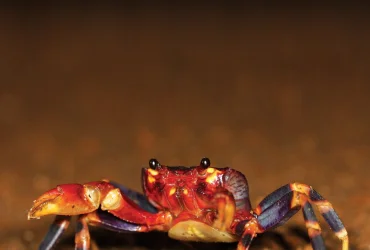 v7i1.152
v7i1.152ISSN: 1800-427X (print)
eISSN: 1800-427X (online)
DOI:10.47605/tapro.v7i1.152
Submitted date: 12 May 2014
Accepted date: 30 November 2014
Published date: 19 January 2015
Pp. 29–37, Pl. 15–17.
EFFECTS OF ENVIRONMENTAL ENRICHMENT ON THE SOCIAL BEHAVIOR OF JAVAN SLOW LORIS, Nycticebus javanicus
Prescillia Rindang Putri, Richard S. Moore, Noviar Andayani, Karmele L. Sanchez
*Corresponding author. E-mail: rindangputri@yahoo.com
Abstract
We conducted a behavioural study on rescued captive N. javanicus housed at International Animal Rescue Centre, West Java, focussing on the frequency of social interactions in relation to varying amounts of enrichment provided. Three different sized cages were chosen comprising a total of ten slow lorises in groups of five, three and two individuals respectively. After providing extra enrichment, we observed a general increase in all social behaviours in both cages, except for proximity and attack. A significant increase in positive social interactions (clasp interaction) was observed when all data combine after environmental enrichment was given. We made sociograms to visualize the significant results of before and after enrichments. The clasp sociogram before enrichments phase revealed that the only male in both cages acted as the initiator of clasp behaviour to other female actors in the cage. This short study reveals positive signs in increasing certain desired behaviours and the role of individuals within the cage during enrichment.
Key words : captive, critically endangered, ex-situ conservation, primates, reintroduction, sociogram
Section Editor: Colin P. Groves
eISSN: 1800-427X (online)
DOI:10.47605/tapro.v7i1.152
Submitted date: 12 May 2014
Accepted date: 30 November 2014
Published date: 19 January 2015
Pp. 29–37, Pl. 15–17.
EFFECTS OF ENVIRONMENTAL ENRICHMENT ON THE SOCIAL BEHAVIOR OF JAVAN SLOW LORIS, Nycticebus javanicus
Prescillia Rindang Putri, Richard S. Moore, Noviar Andayani, Karmele L. Sanchez
*Corresponding author. E-mail: rindangputri@yahoo.com
Abstract
We conducted a behavioural study on rescued captive N. javanicus housed at International Animal Rescue Centre, West Java, focussing on the frequency of social interactions in relation to varying amounts of enrichment provided. Three different sized cages were chosen comprising a total of ten slow lorises in groups of five, three and two individuals respectively. After providing extra enrichment, we observed a general increase in all social behaviours in both cages, except for proximity and attack. A significant increase in positive social interactions (clasp interaction) was observed when all data combine after environmental enrichment was given. We made sociograms to visualize the significant results of before and after enrichments. The clasp sociogram before enrichments phase revealed that the only male in both cages acted as the initiator of clasp behaviour to other female actors in the cage. This short study reveals positive signs in increasing certain desired behaviours and the role of individuals within the cage during enrichment.
Key words : captive, critically endangered, ex-situ conservation, primates, reintroduction, sociogram
Section Editor: Colin P. Groves
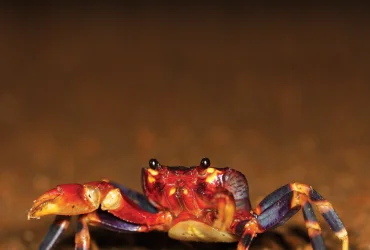 v7i1.151
v7i1.151ISSN: 1800-427X (print)
eISSN: 1800-427X (online)
DOI:10.47605/tapro.v7i1.151
Submitted date: 12 May 2014
Accepted date: 30 November 2014
Published date: 19 January 2015
Pp. 20–28, Pl. 12–14.
SPATIAL DISTRIBUTION AND HABITAT CORRELATES OF NILGIRI WOOD-PIGEON (Columba elphinstonii) IN NORTH WESTERN GHATS, INDIA
Pankaj Koparde, Monali Mhaskar, Prachi Mhaske & Ankur Patwardhan
*Corresponding author. E-mail: pankajkoparde@gmail.com
Abstract
Nilgiri wood-pigeon (Columba elphinstonii) was surveyed in two forest types (open and closed) for spatial distribution and habitat correlates using belt transects across 94 localities in Sahyadri Tiger Reserve, India, during 2011–2013. Only closed forested localities showed presence of the species with maximum number of individuals sighted in evergreen forests. Poisson multiple regression analysis was conducted on species abundance data from 18 sites and seven variables. The species was found to be associated with high canopy cover and evergreen forests. Suitable habitat of the species was predicted using MaxEnt model. MaxEnt model showed high degree of suitable habitat in west Chandoli National Park and the corridor area of the tiger reserve. This paper provides fine scale distribution data and habitat correlates and discusses potential threats to the species in north Western Ghats and stresses the immediate need for conservation action in this area.
Key words : avifauna, biogeography, conservation, distribution, ecology, endemic, habitat, threatened
Section Editor: Varadharajan Gokula
eISSN: 1800-427X (online)
DOI:10.47605/tapro.v7i1.151
Submitted date: 12 May 2014
Accepted date: 30 November 2014
Published date: 19 January 2015
Pp. 20–28, Pl. 12–14.
SPATIAL DISTRIBUTION AND HABITAT CORRELATES OF NILGIRI WOOD-PIGEON (Columba elphinstonii) IN NORTH WESTERN GHATS, INDIA
Pankaj Koparde, Monali Mhaskar, Prachi Mhaske & Ankur Patwardhan
*Corresponding author. E-mail: pankajkoparde@gmail.com
Abstract
Nilgiri wood-pigeon (Columba elphinstonii) was surveyed in two forest types (open and closed) for spatial distribution and habitat correlates using belt transects across 94 localities in Sahyadri Tiger Reserve, India, during 2011–2013. Only closed forested localities showed presence of the species with maximum number of individuals sighted in evergreen forests. Poisson multiple regression analysis was conducted on species abundance data from 18 sites and seven variables. The species was found to be associated with high canopy cover and evergreen forests. Suitable habitat of the species was predicted using MaxEnt model. MaxEnt model showed high degree of suitable habitat in west Chandoli National Park and the corridor area of the tiger reserve. This paper provides fine scale distribution data and habitat correlates and discusses potential threats to the species in north Western Ghats and stresses the immediate need for conservation action in this area.
Key words : avifauna, biogeography, conservation, distribution, ecology, endemic, habitat, threatened
Section Editor: Varadharajan Gokula
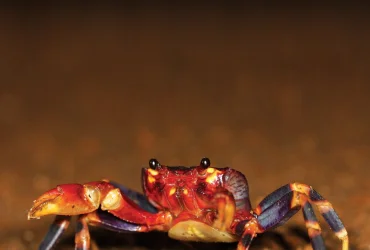 v7i1.150
v7i1.150ISSN: 1800-427X (print)
eISSN: 1800-427X (online)
DOI:10.47605/tapro.v7i1.150
Submitted date: 22 February 2014
Accepted date: 30 July 2014
Published date: 19 January 2015
Pp. 14–19, Pl. 9–11.
PREYING FREQUENCY OF COMMON KINGFISHER, Alcedo atthis (LINNAEUS, 1758) IN BANGLADESH
Habibon Naher
*Corresponding author. E-mail: habibonnaher@yahoo.com
Abstract
A study on the preying frequency of common kingfisher (Alcedo atthis) was conducted from September 2008 to September 2011 at Nikunja-1 in Dhaka City Corporation Area of Bangladesh. The objective of the study was to determine the average preying frequency per day across different months using focal animal sampling method. It preyed 8.5 times / day, with the highest frequency of preying at 11:01–12:00 h and 16:01–17:00 h. The average frequency was highest in September and lowest in April and highest in monsoon season and lowest in summer. Food items comprised of arthropods (31.7%) and fish (68.3%). From May through September, they avoided arthropods preferring fish as it was peak breeding season. During this period, they were preoccupied with courtship, nest building and caring of their nestlings.
Key words : breeding season, behaviour, Dhaka City, feeding activities, monsoon, summer
Section Editor: Varadharajan Gokula
eISSN: 1800-427X (online)
DOI:10.47605/tapro.v7i1.150
Submitted date: 22 February 2014
Accepted date: 30 July 2014
Published date: 19 January 2015
Pp. 14–19, Pl. 9–11.
PREYING FREQUENCY OF COMMON KINGFISHER, Alcedo atthis (LINNAEUS, 1758) IN BANGLADESH
Habibon Naher
*Corresponding author. E-mail: habibonnaher@yahoo.com
Abstract
A study on the preying frequency of common kingfisher (Alcedo atthis) was conducted from September 2008 to September 2011 at Nikunja-1 in Dhaka City Corporation Area of Bangladesh. The objective of the study was to determine the average preying frequency per day across different months using focal animal sampling method. It preyed 8.5 times / day, with the highest frequency of preying at 11:01–12:00 h and 16:01–17:00 h. The average frequency was highest in September and lowest in April and highest in monsoon season and lowest in summer. Food items comprised of arthropods (31.7%) and fish (68.3%). From May through September, they avoided arthropods preferring fish as it was peak breeding season. During this period, they were preoccupied with courtship, nest building and caring of their nestlings.
Key words : breeding season, behaviour, Dhaka City, feeding activities, monsoon, summer
Section Editor: Varadharajan Gokula
Hubungi Kami
The ultimate aim of the journal is to provide an effective medium for communication of the latest and best scientific information.
Copyright © 2020 Taprobanica. All Rights Reserved
Jasa Pembuatan Website by IKT




